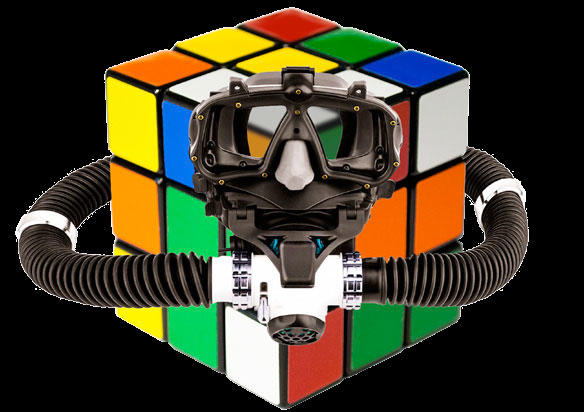I have known since my first days as a diver that people under stress are fighting panic and tend to make wrong choices. In an emergency, divers need a limited number of survival responses. The main danger with Scuba is no air. We need to get gas quickly, either from a buddy or the surface. Simple.
Rebreathers though can be quite complex as the manufacturer attempts to make them ‘hands-off’ or ‘fool proof’. As divers, we are taught to develop muscle memory so when a problem occurs we choose the correct response. With some rebreathers we are offered too many choices – which one do we select when we are stressed? Have we practiced all the drills since completing our training. Remember that we are often in deco so can’t just free ascend to the surface.
Within the Tech Dive community there is a mantra that too many gadgets equals too many points of potential failure. This does not seem to apply to rebreathers. My first CCR gave me a huge number of options depending on the problem I was presented with. Each one of those options had to go into the memory bank, and individual muscle memories had to be developed. My chest seemed to be covered in hoses, counter-lungs and fittings of various descriptions. To make matters worse, I had to learn drills for all these mechanical and electronic gadgets.
We are told during CCR training that we have more time to sort out a CCR problem than we do a Scuba problem. Usually a catastrophic failure on Scuba results in a sudden massive loss of air. Being out of air is easily recognized as there are masses of noisy bubbles and we inhale water, or nothing at all. Some CCR failures are insidious and develop over time, while others lead to unconsciousness very quickly. So what can we do about it?
The logical thing would be to simplify the rebreather operation and reduce the points of potential failure. ‘Simple’ is less likely to go wrong, particularly if it allows us to bail out.
Now I hear you asking “isn’t that a retrograde step?” Well, do you carry a spare wheel for your car? Do you have an Octi/ Air2 on your Scuba gear? Do you have a gas redundancy built into your Tech dive gear? It is good safe dive practice to have a redundancy for key functions, and breathing is a key function!
My first CCR did not have a bailout valve so I had to shut my loop, find my off-board valve, turn on the gas supply and then locate and secure my regulator. That is a lot to do if you are suffering diminished consciousness. My next CCR was a KISS Classic that had a Bail Out Valve (BOV) as a standard fitting. This is a wonderful device as one muscle memory will solve most CCR problems. Believe it or not, many manufactures still do not provide a bail-out valve as a part of their CCR. In times of stress the diver simply turns the BOV lever and breathes from their off-board gas supply. Now their choice is: calmly fix the CCR problem or ascend on Bailout.
I have dived my KISS Classic mCCR in Truk, Scapa Flow, Solomoms, Vanuatu, Australia and around New Zealand’s lakes, shores and islands without incident or breakdown. Nevertheless, my CCR training reminds me that no matter how well prepared we are, disasters can happen very quickly. That being the case I practice and practice my drills. The one I really need to be expert with is the quarter turn of the BOV lever.
Expert CCR Mixed Gas Instructor Trainer Paul Haynes says “… the most technically sophisticated option need not necessarily be the safest option; the more complex the engineering the greater the potential number of failure modes that may be inherent within the design. There is a strong case for ‘less is best’ …”
Nowadays we are inundated with rebreathers that are attempting to seduce the recreational and technical markets. They are all safer, smarter, more innovative than existing proven designs. It is easy to be seduced by fashion appeal and buy a CCR that is far too sophisticated for your intended use.
My experience is that eCCRs can be quite cantankerous in shallower water. Stability and reliability are just as important in shallow water as in deep. If you have limited CCR experience, you need to look beyond fashionable ‘sophisticated’ designs to identify CCRs with life sustaining safe design considerations. We don’t plan for CCRs to fail, but from time to time and for various reasons, they do. Make sure the CCR you have will give you the best chance of surviving.
My choice in CCRs is the KISS brand because it retains one of the best safety records of any commercially built recreational or technical CCR. For excellent reasons the KISS Classic has remained virtually unchanged since it was first introduced in 1999. It is that good. KISS has earned a reputation for the most durable, reliable and easiest to maintain closed circuit rebreathers on the market. That is why the Classic was chosen for the harsh, and extremely rugged Mexican Sistema Huautla Expedition that set the Western Hemisphere cave depth record in 2013. The lighter weight Spirit LTE is another excellent mCCR capable of 91m. It is an innovative design based on simplicity and reliability. The Spirit LTE is ideal for the travelling Recreational or Technical diver.
We all know KISS means: Keep It Simple Stupid. Nowadays we might say the KISS mCCRs are Super Simple. If you are looking for a CCR that is safe, light, simple to use, simple to problem solve and reliable in the harshest of conditions, choose KISS.
Learn more about diving a KISS CCR in New Zealand at: http://scubadiving.co.nz/what-we-offer/the-kiss-mccr/





